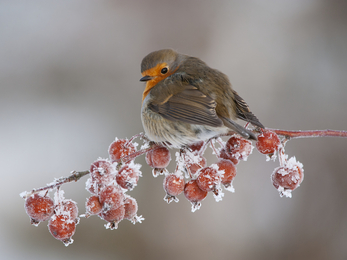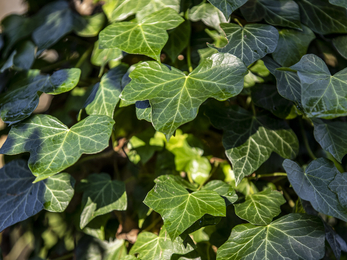Dormice are snuggled up in their nests whilst they hibernate and frogs retreat to the bottom of ponds, burying themselves in silt and breathing through their skin. Trees and bushes have dropped their leaves, exposing their skeletons as they enter their winter dormancy period. Naturally, we can feel a bit vulnerable in this harsh landscape. But if you can wrap up and coax yourself outside for a couple of hours and really make an effort to notice things, you may be able to feel a sense of awe at the raw yet delicate beauty of winter. At first the land might seem stark and quiet but have a look for any patches of green amongst the browns and beiges. A few plants keep their leaves through winter, known as evergreen plants. If you’re quiet and patient, you might see and hear a flutter or scurry of life surrounding these plants, probably in search of a meal.
Look out for ivy climbing up tree trunks and blanketing over rocks. Ivy is in flower until November, much later than most plants, attracting several species of insects. These in turn provide a late food source for robins and wrens which you may spot hopping around in winter. Ivy flowers also provide a final nectar source for many pollinating insects, like bees, before they go into hibernation. Small mammals and bats shelter in their thick leaves. The berries don’t ripen until mid-winter, providing a high-fat energy source for birds during the season’s food gap – keep an eye out for woodpigeons, thrushes, jays, starlings, finches and blackbirds devouring them.
You may notice holly bushes dotted around with their spiky, waxy leaves. Holly berries contain the seeds and are eaten by several animals including birds, for example fieldfares, redwings, blackbirds and thrushes. In return, the birds unknowingly spread the holly’s seed around in their droppings. Holly is clever in controlling how its seeds are spread. Firstly, its berries don’t ripen until winter when there isn’t much other fruit around, so they have a higher chance of being eaten by a bird or other animal. Secondly, the berries are mildly toxic so birds can only eat a few at a time meaning they have to return more often. So, droppings each contain fewer seeds but are spread out over a larger area, increasing the likelihood of the holly’s seeds landing in a suitable place to grow. Not just a pretty Christmas decoration!
Look up to the trees to see if you can spot clumps of green amongst the otherwise bare branches. This may well be mistletoe. Mistletoe is partially parasitic - it grows on tree branches, taking some of its nutrients and water. Its berries are white and very enticing to birds like the mistle thrush, who eat the high-fat fruit surrounding the seed. The seed itself is covered in a very sticky substance, so it gets stuck to the bird’s beak. Once the bird notices, it starts wiping its beak on a new branch in frustration. Once stuck to the branch, the seed’s sticky coat hardens, attaching the seed to the spot where it then takes root. In ancient times, mistletoe symbolised life and fertility because of the fact it was seen mysteriously growing, without soil, amongst dead-appearing branches. This may be where the kissing tradition stems from!
Getting outside in winter gives you a chance to see the natural world when there aren’t many other people are about. So put your layers on, look for some evergreen plants and watch what goes on around them when the world is quiet. You can do this in a nearby park or wildlife site, and you could also head to one of our amazing nature reserves. Plan your visit at www.avonwildlifetrust.org.uk/nature-reserves.



